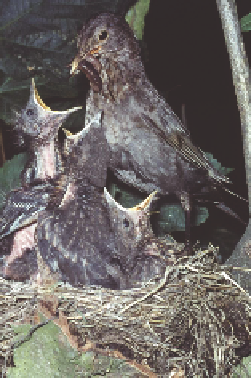Biology Reference
In-Depth Information
Brood hierarchy
Mean no. young surviving to two weeks
after fledging (n
=
no. broods)
Table 8.5
Robert
Magrath's (1989)
experiment with
blackbirds, to test
the influence of a
brood hierarchy
on the parent's
reproductive
success. All
broods were of
four chicks
(Synchronous,
same size;
Asynchronous,
different size).
Photo of a female
blackbird feeding
a worm to her
chicks © W.B.Carr.
Good food supply
Poor food supply
Synchronous hatching
2.9 (n
=
8)
1.3 (n
=
21)
Asynchronous hatching
2.3 (n
=
13)
2.1 (n
=
25)
profited by beginning incubation before their clutch was complete, because the resulting
asynchronous hatching produced a brood hierarchy which led to efficient brood
reduction if food was scarce. By contrast, Lack supposed that synchronous hatching
would produce chicks of similar size; with no clear dominance hierarchy among the
brood a parent would waste resources on producing many weedy offspring, all with
poor survival prospects, rather than a few, healthy survivors.
Robert Magrath (1989) has provided experimental evidence in favour of Lack's view
that parents influence the degree of sibling rivalry to optimize their own reproductive
success. He studied blackbirds
Turdus merula
, a member of the thrush family which feeds
its chicks largely on earthworms, whose availability varies unpredictably with rainfall.
Blackbirds normally have asynchronous hatching and the younger members of the brood
often starve to death during dry spells, when worms are too deep in the soil for the blackbirds
to reach. Magrath created experimental broods of four chicks by swapping newly-hatched
young between nests. There were two treatments: synchronous broods had chicks of
similar size, while asynchronous broods had a size hierarchy of the same magnitude as
natural broods. Conditions were rather dry during the experiment, so Magrath was able to
compare productivity of the two brood types under these poor conditions and in good
conditions, where he provided some pairs experimentally with extra food.
As predicted by Lack's hypothesis, under poor conditions asynchronous broods
produced more surviving young than did synchronous broods (Table 8.5) because, with
Brood hierarchies
facilitate brood
reduction


















































